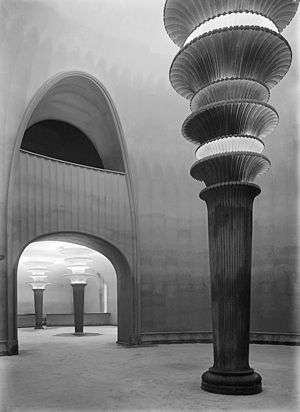Großes Schauspielhaus

The Großes Schauspielhaus (Great Theater) was a theatre in Berlin, Germany, often described as an example of expressionist architecture, designed by Hans Poelzig for theatre impresario Max Reinhardt. The structure was originally a market built by architect Friedrich Hitzig, and it retained its external, gabled form. It then became the Zirkus Schumann, a circus arena. It was renovated by Poelzig and reopened in 1919, contained seating for 3500 people. Max Reinhardt wanted to attract a working class audience to the theater. The large size allowed for people who could pay top prices for the best seats to support the low-cost seats in the back of the theater.
It was painted red. It was a cavernous, domed space and had no balconies, which contributed to its vastness. The dome and pillars were decorated with maquernas, a honeycombed pendentive ornament, which resembled stalactites. When illuminated, the ceiling's lightbulbs formed patterns of celestial constellations, and the vaulted ceiling took on another concept, the night sky. In the lobby and elsewhere, Poelzig made use of colored lightbulbs to create striking visual backdrops. Separate entrances were provided for the expensive and the cheap seats. The theatre also included a restaurant for the wealthy audience members, a cafeteria for the poorer audience members, and a bar. The performers and technicians enjoyed their own bar, a barber shop, ample dressing room space, and the modern stage equipment.
The Nazis took over the theater in 1933. They changed the name to The Theater of the People. The Nazis, who described this building as an example of Entartete Kunst, refurbished the theater on the interior by adding a hung ceiling to hide the stalactite forms. After World War II, the theater was used for variety shows under the name of Friedrichstadt-Palast until 1988 when it was condemned and demolished. The reason was a strong subsidence of the foundation as well as the moulding of the supporting piles.
The new Friedrichstadt-Palast has been erected on Friedrichstraße 107.
References
- Dawson, Layla (May 2008). "Prolific Poelzig". The Architectural Review. CCXXIII (1335): 96–97.
Coordinates: 52°31′22″N 13°23′10″E / 52.52278°N 13.38611°E